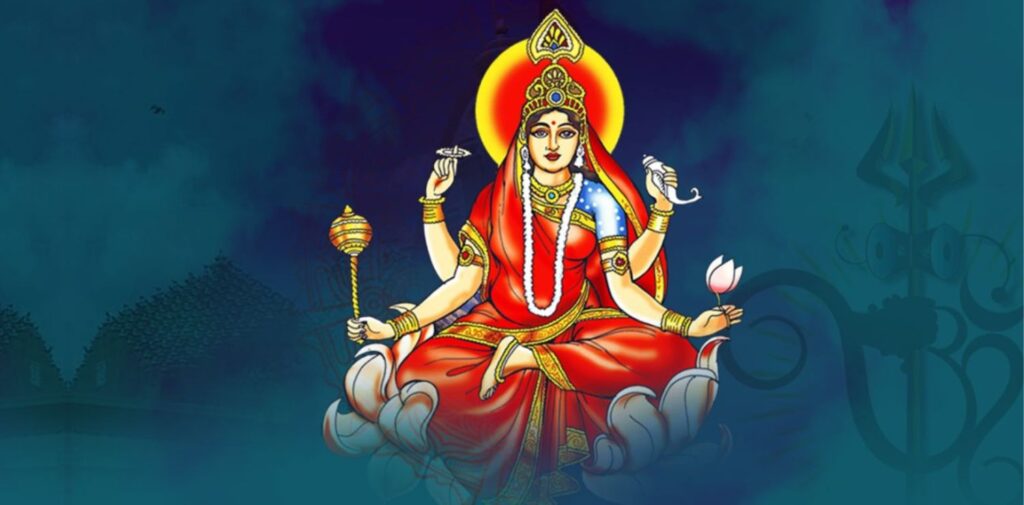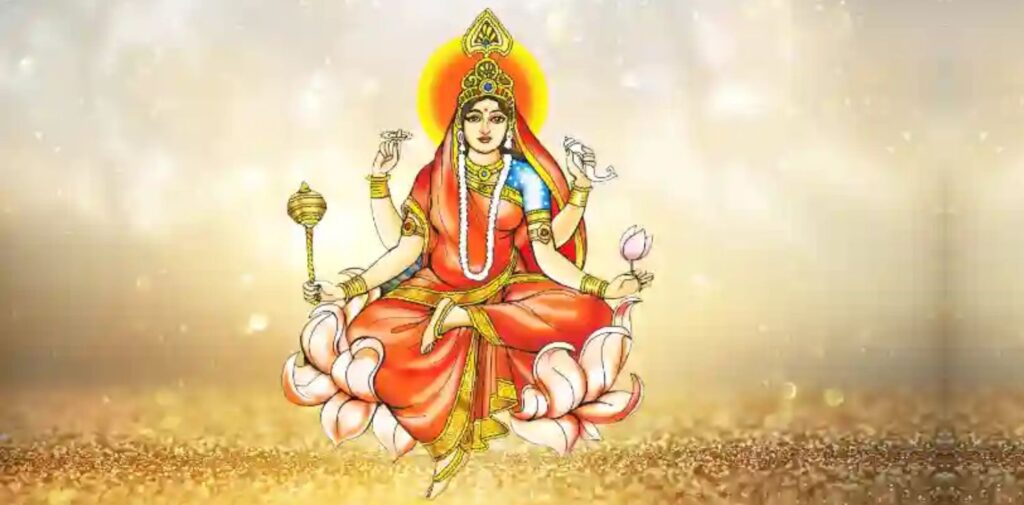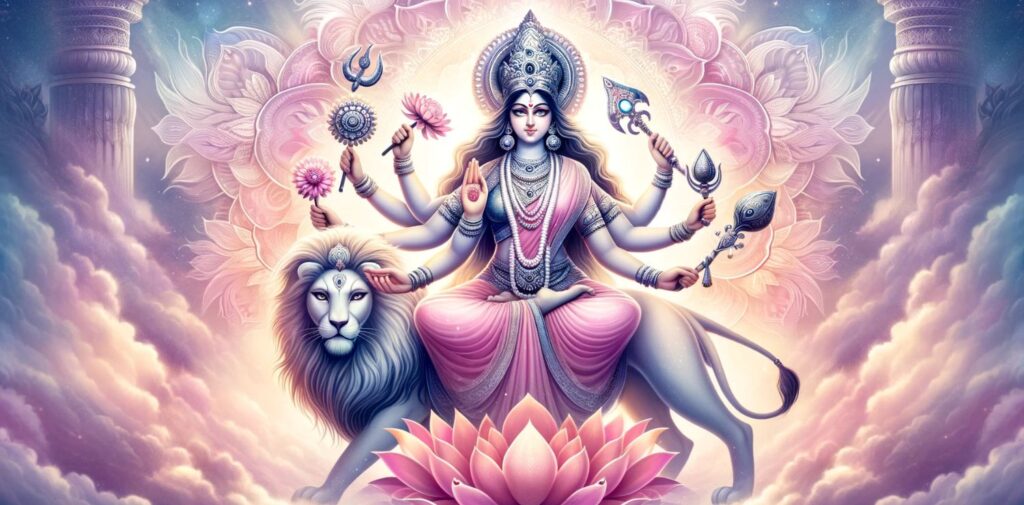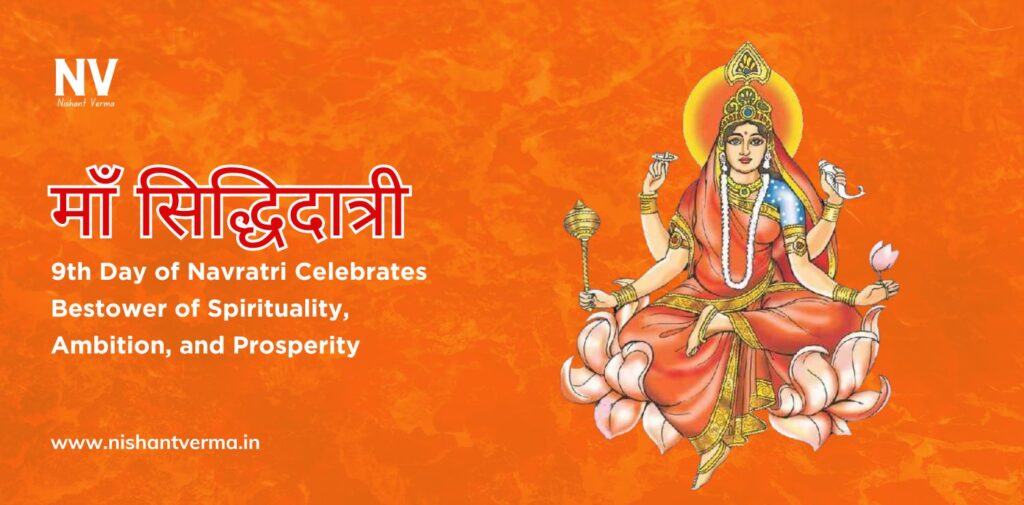Navratri, the nine-day Hindu festival, holds immense spiritual significance, with each day dedicated to a different form of Goddess Durga. The ninth day of Navratri is celebrated as the day of Goddess Siddhidatri. As the name suggests, ‘Siddhi’ means supernatural power or meditative ability, and ‘Datri’ means the giver. Thus, Goddess Siddhidatri is revered as the one who bestows various forms of Siddhis (supernatural powers) and brings prosperity, ambition, and spiritual enlightenment into our lives.
Who is Goddess Siddhidatri?
Goddess Siddhidatri is the ninth and final form of Maa Durga worshipped during Navratri. She is depicted as a divine being with four arms, holding a conch shell, discus, lotus, and a mace. She sits on a lotus and rides a lion. Her serene face and divine aura symbolize ultimate bliss, grace, and accomplishment. She is believed to bless her devotees with all the Ashta Siddhis (eight forms of supernatural powers) that allow them to achieve greatness in both the material and spiritual world.

The legend of Goddess Siddhidatri finds its mention in various Hindu scriptures and mythology. According to the Puranas, she appeared from the left half of Lord Shiva’s body. Therefore, Lord Shiva is also known as Ardhanarishwar—half man and half woman, as a representation of both Shiva and Shakti. Goddess Siddhidatri completes Lord Shiva’s existence, highlighting the importance of balance between male and female energies in the universe.
Significance of Goddess Siddhidatri in Our Lives
Goddess Siddhidatri is considered the epitome of perfection and completeness. She signifies the ultimate realization that nothing is impossible for those who are steadfast in their devotion, sincere in their efforts, and pure in their hearts. Worshipping her on the ninth day of Navratri can bring several benefits:
Spiritual Upliftment: Goddess Siddhidatri helps her devotees attain spiritual enlightenment and deep meditative powers. Her blessings can lead one to achieve inner peace, harmony, and understanding of life’s deeper meanings.
Ambition and Success: She grants her devotees the courage and energy to pursue their ambitions. With her blessings, obstacles in the path of success are removed, and one finds the strength to achieve their goals.

Prosperity and Wealth: Goddess Siddhidatri bestows prosperity and material wealth upon her devotees. Her grace ensures abundance and helps in achieving financial stability and success in life.
Completion and Perfection: She symbolizes the state of absolute perfection. Praying to her means seeking completeness in one’s endeavors and attaining the highest form of knowledge and wisdom.
Removal of Negativity: Goddess Siddhidatri destroys negative energies and evil influences. She fills the atmosphere with positivity, providing protection and strength to overcome any adversities.
Story of Goddess Siddhidatri
According to Hindu mythology, when the universe was created, Lord Shiva wanted to understand the meaning of divine powers. He prayed to Goddess Shakti, who appeared in the form of Siddhidatri and bestowed him with all the eight Siddhis—Anima (ability to become as small as an atom), Mahima (ability to become as large as the universe), Garima (ability to become infinitely heavy), Laghima (ability to become weightless), Prapti (ability to acquire anything desired), Prakamya (ability to realize whatever one desires), Ishitva (lordship), and Vashitva (control over nature).
Goddess Siddhidatri, being the giver of these divine powers, transformed Lord Shiva into Ardhanarishwar, representing the amalgamation of male and female energies, symbolizing that Shiva (consciousness) and Shakti (energy) are inseparable. This union stands for the completeness of existence, highlighting that one cannot function without the other.
How to Worship Goddess Siddhidatri on the Ninth Day of Navratri
Worshipping Goddess Siddhidatri on the ninth day of Navratri is believed to fulfill the wishes of devotees, especially those seeking spiritual progress and inner contentment. The following rituals are generally performed:
Setting up the Altar: Place a clean and sacred cloth on the altar and adorn it with fresh flowers. Place an idol or picture of Goddess Siddhidatri on the altar.
Offering Prayers: Light a lamp and incense sticks, and offer flowers, fruits, and sweets to the Goddess. One can chant the Siddhidatri mantra—”Om Siddhidatri Namah”—to invoke her blessings.
Reciting Durga Saptashati: Reading the Durga Saptashati or Durga Chalisa is considered auspicious. These texts narrate the divine stories of Goddess Durga and her various forms, bringing a sense of fulfillment and peace.

Performing Aarti: Performing Aarti with devotion and singing praises of the Goddess is a way of seeking her blessings. It is a ritual that purifies the atmosphere and connects the devotees with the divine.
Offering Bhog: Devotees offer Kheer (a sweet rice pudding) as Bhog to the Goddess. This dish is considered her favorite. After offering, it is distributed as Prasad among family members and friends.
Fasting and Meditation: Many devotees observe fast on this day to cleanse their body and mind. They engage in meditation and chanting to seek the blessings of Goddess.
The Ashta Siddhis Bestowed by Goddess Siddhidatri
As mentioned earlier, Goddess Siddhidatri grants eight Siddhis to her devotees. Let’s understand these Siddhis briefly:
- Anima: The power to reduce one’s body to an incredibly small size, even becoming as minute as an atom.
- Mahima: The power to expand one’s body to an infinitely large size.
- Garima: The ability to become infinitely heavy.
- Laghima: The ability to become weightless.
- Prapti: The power to acquire anything desired, like accessing any place or object.
- Prakamya: The power to achieve or realize whatever one desires.
- Ishitva: The power of absolute lordship over nature, allowing the user to create or destroy.
- Vashitva: The ability to control others, including nature, minds, and objects.
Conclusion: The Essence of Worshipping Goddess Siddhidatri
On the ninth day of Navratri, devotees seek the blessings to attain spiritual elevation, material success, and inner fulfillment. Her worship is not just a means to seek divine powers but a path to realizing one’s true potential and achieving harmony between the body, mind, and soul.
Goddess Siddhidatri, through her grace, helps us understand that true wealth lies in spiritual growth and inner peace. While material prosperity is essential, it is incomplete without spiritual awareness. Thus, the ninth day of Navratri is a celebration of achieving perfection in every aspect of life.
May the blessings of Goddess Siddhidatri bring success, prosperity, and spiritual enlightenment into your lives. Happy Navratri!




